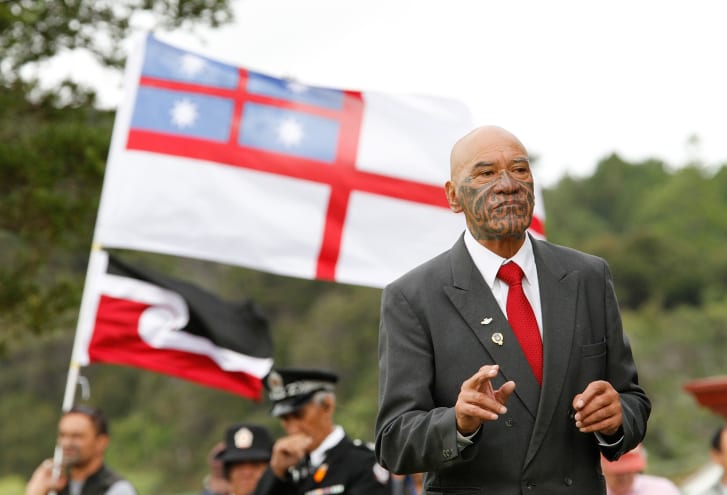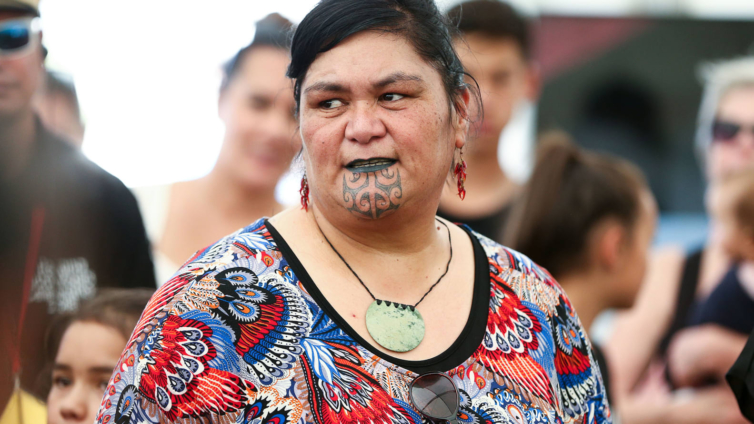
Audio By Carbonatix
Politician Nanaia Mahuta made history this week when she was named New Zealand's first Indigenous female foreign minister.
But for those with traditional Māori tattoos, known as moko, she has long been breaking down barriers.In 2016, after taking part in a Māori tattooing design ceremony, Mahuta became the first female member of parliament to wear lip and chin markings, or moko kauae.
Traditional tattoos offer "positive ways to enable cultural expression and pride in being Māori," she tweeted last year.
Kirituhi and Tā Moko are positive ways to enable cultural expression and pride in being Māori #acknowledgingancestors
— Nanaia Mahuta (@NanaiaMahuta) March 21, 2019
While still a rare sight in national politics, facial moko are increasingly common in contemporary New Zealand society. The tattoos often carry huge cultural significance for the wearer, telling a visual story that connect Indigenous people to their ancestors.
Each individual's moko is unique and may relate to their social status, occupation or personal and family history. The complex designs also allude to the wearer's genealogy (which in Mahuta's case, ties her to the late Māori queen, Te Arikinui Te Atairangikaahu and the current Māori monarch, Kingi Tuheitia, according to Radio New Zealand).
Markings on the left and right sides of the face refer to the lineage of a person's father and mother, respectively.

For Te Kahautu Maxwell, an associate professor at the University of Waikato (and the great-great-grandson of a moko artist), getting a facial tattoo around 10 years ago was about "reclaiming" his heritage.
"It's about my heritage and my place in society as a historian, an academic and an orator or spokesperson for my people," he said in a phone interview. "It brings me a sense of pride and it brings my people a sense of pride."It's also tells the history of my life," he added. "It's something that's very sacred and precious to me."
Steeped in Tradition
The practice of tattooing -- known as tā moko -- is believed to take its name from Rūaumoko, the Māori god of earthquakes and volcanoes.
A common origin story involves a mythological figure, Mataoro, who fell in love with and married Niwareka, the daughter of an underworld ruler.After beating her in fit of rage, Mataoro followed his wife to the underworld to seek forgiveness.
While there, Niwareka's father taught him the art of tā moko and, sanctioning his return to the "upper" world, marked him with tattoos as a reminder to avoid future acts of evil.

Moko ceremonies have historically been surrounded with customs and ritual. They often took place in temporary outdoor shelters, with the person being tattooed only permitted to eat through a carved funnel, which also helped to reduce the likelihood of infection.
The recipient would be expected to abstain from sexual contact or washing while they healed.
Traditionally, men would have markings on their face, buttocks and thighs, while women usually carried them on their lips and chin.
Though tattooing has been practiced in Polynesian societies for centuries, Māori groups developed their own specific techniques and tools.
Organic pigments -- made by burning resin from kauri trees, and mixing the soot and with oil or other liquids -- would be chiseled beneath the top layers of skin using tools forged from bird bones, commonly those of albatrosses. (Around the turn of the 20th century, the use of needles became more common, while today, modern tattooing machines are also used.)
The prevalence of facial moko went into decline following the arrival of Europeans -- not least because the preserved heads of tattooed Māori warriors became highly coveted among colonizers. Facial tattoos' association with gangs or criminality in other cultures may also have contributed to their decline.

But with renewed interest in traditional Māori art forms like wood carving, and the increasing acceptance of tattoos in wider New Zealand society, the art of tā moko has witnessed something of a resurgence in recent decades.
Maxwell, who is aged 54, said that the "normalization" of traditional tattoos in New Zealand began in the 1990s and 2000s, after earlier generations had distanced themselves from the practice.
"There was lots of negativity, not just from non-Māori communities but also from our own communities, because our parents and grandparents were of the mind that the moko should be left in the past.
"But we, the younger generation of that time, weren't prepared to let the art form become a memory, (so we chose) to bring it back as a living art form and to announce to the world that we are Māori."
Opportunities to educate
While Maxwell said he had "experienced no stigma" as a result of his moko, there have been periodic reports of Indigenous people being refused service in bars or restaurants as a result of having visible tattoos.
Yet, there are also a growing number of high-profile figures with facial markings in New Zealand society, such as journalist Oriini Kaipara, who last year became the first woman with moko kauae to present the news on a mainstream TV station.

With growing visibility has come instances of alleged cultural appropriation. Mike Tyson, Rihanna and British pop star Robbie Williams have all been criticized for adopting Māori-style tattoos in recent years. Fashion designer Jean-Paul Gaultier also stirred controversy in 2007, when he applied moko-inspired designs to Caucasian models' faces for a fashion campaign.
Maxwell, however, welcomes interest from other cultures, seeing it as a chance to educate people about Māori traditions.
He described Mahuta's recent appointment as one such opportunity, seeing it as "significant moment" for Indigenous communities.
"She will take the moko to places it has never been before -- to consulates, to embassies and government offices throughout the world," he said.

Rukuwai Tipene-Allen, a political journalist for Māori Television who wears a facial moko meanwhile said that the appointment "shows that our culture has a place at an international level."
"The first face that people see at an international level is someone who speaks, looks and sounds like a Māori," she told CNN earlier this week, adding: "Wearing the markings of her ancestors shows people that there are no boundaries to Māori and where they can go."
Latest Stories
-
‘Adom FM’s Strictly Highlife’ lights up La Palm with a night of rhythm and nostalgia
5 minutes -
Ghana is rising again – Mahama declares
5 hours -
Firefighters subdue blaze at Accra’s Tudu, officials warn of busy fire season ahead
5 hours -
New Year’s Luv FM Family Party in the park ends in grand style at Rattray park
5 hours -
Mahama targets digital schools, universal healthcare, and food self-sufficiency in 2026
6 hours -
Ghana’s global image boosted by our world-acclaimed reset agenda – Mahama
6 hours -
Full text: Mahama’s New Year message to the nation
6 hours -
The foundation is laid; now we accelerate and expand in 2026 – Mahama
6 hours -
There is no NPP, CPP nor NDC Ghana, only one Ghana – Mahama
6 hours -
Eduwatch praises education financing gains but warns delays, teacher gaps could derail reforms
7 hours -
Kusaal Wikimedians take local language online in 14-day digital campaign
7 hours -
Stop interfering in each other’s roles – Bole-Bamboi MP appeals to traditional rulers for peace
8 hours -
Playback: President Mahama addresses the nation in New Year message
8 hours -
Industrial and Commercial Workers’ Union call for strong work ethics, economic participation in 2026 new year message
10 hours -
Crossover Joy: Churches in Ghana welcome 2026 with fire and faith
10 hours

